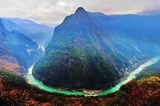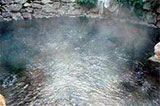
Located in the southwest frontier of the People's Republic of China, Tibet Autonomous Region has an area of over 1.2 million square kilometers, which makes up one-eighth of the total national area, only second to Xinjiang Uygur Autonomous Region. With the average elevation of over 4,000 meters, Tibet is the plateau region with the largest space and the highest sea level in the world, which is dubbed "the World Ridge" and "the Third Pole on the Globe". Tibet is contiguous to Xinjiang Uygur autonomous Region and Qinghai Province by the Kunlun and the Tanggula Mountains on the north, looks at Sichuan Province across the Jinsha River on the east, is connected with Yunnan Province on the southeast, borders Myanmar, India, Bhutan, Sikkim, Nepal and Kashmir. With nearly 4,000 kilometers land boundary line, it is China's southwest barrier.
Famous for peculiar geological features, magnificent natural scenery, splendid ethnic culture and characteristic local customs and practices, Tibet has become the Holy Land for numerous Chinese and overseas tourists, mountain explorers and scientific surveyors.
Geographically, Tibet can be divided into three major parts, the east, north and south. The eastern part is forest region, occupying approximately one-fourth of the land. Virgin forests run the entire breadth and length of this part of Tibet. The northern part is open grassland, where nomads and yak and sheep dwell here. This part occupies approximately half of Tibet. The southern and central part is agricultural region, occupying about one-fourth of Tibet's land area.
With all major Tibetan cities and towns such as Lhasa, Shigatse, Gyantse and Tsedang located in this area, it is considered the cultural center of Tibet. The total area of the Tibet Autonomous Region is 1,200,000 square kilometers and its population is 1,890,000. The region is administratively divided into one municipality and six prefectures. The municipality is Lhasa, while the six prefectures are Shigatse, Ngari, Shannan, Chamdo, Nagchu and Nyingchi.
 Major Rivers that Originate from the Tibetan Plateau
Major Rivers that Originate from the Tibetan Plateau Hot Springs in Central Tibet (Tibet Autonomous Region)
Hot Springs in Central Tibet (Tibet Autonomous Region) Vegetation on Tibetan Plateau
Vegetation on Tibetan Plateau Animals on Tibetan Plateau
Animals on Tibetan Plateau Highland Barley on Tibetan Plateau
Highland Barley on Tibetan Plateau Mountains on Tibetan Plateau
Mountains on Tibetan Plateau Lakes in Amdo and Kham Tibetan Areas
Lakes in Amdo and Kham Tibetan Areas Lakes in Central Tibet (Tibet Autonomous Region)
Lakes in Central Tibet (Tibet Autonomous Region) Difference Between Tibet Autonomous Region and Tibetan Areas
Difference Between Tibet Autonomous Region and Tibetan Areas